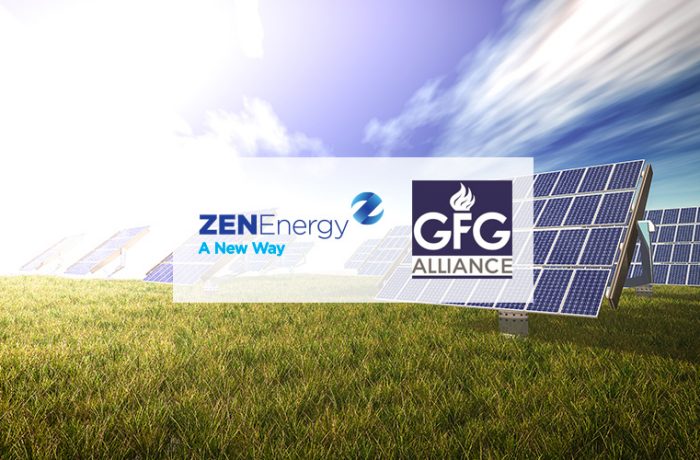
Image: Zen Energy
Large-scale solar PV, a major battery system, pumped hydro storage and demand response projects were approved by Zen Energy’s Board yesterday morning.
Yesterday’s Board meeting was the first since GFG Alliance, the saviour of Whyalla Steelworks, acquired a controlling stake in Zen Energy last month. GFG Alliance’s Sanjeev Gupta has assumed the role of Chairman, a role previously fulfilled by Professor Ross Garnaut 1, who is now President of the company.
The meeting provided endorsement for a gigawatt of additional dispatchable renewable generation assets to help service long-term electricity supply contracts with large industrial electricity consumers in South Australia, including the Liberty OneSteel Whyalla Steelworks.
The approved projects:
- 200MW of solar PV, consisting of 80MW in the Whyalla Council industrial area, with another 120MW on adjacent land owned by Liberty OneSteel (A GFG Alliance company).
- A 100MW/100MWh battery system at Port Augusta – previously referred to as the Big Battery Project
- 100MW of demand response at the Whyalla Steelworks (acquired by GFG Alliance in August) and other sites in South Australia.
- A 120MW/600MWh pumped hydro storage facility at a disused iron ore mine pit in the Middleback Ranges, which is in the north east corner of Eyre Peninsula, south-west of Whyalla.
- 480 MW of additional solar power capacity to support industrial capacity expansion in Whyalla and other industrial loads in South Australia. This element appears to be contingent on how national electricity policy is resolved.
“These first steps in SA will improve reliability and greatly reduce costs of electricity in our own steelworks at Whyalla, and provide competitive sources of power for other industrial and commercial users,” said Mr. Gupta. ” This will be followed by early steps to lower Liberty OneSteel’s electricity costs in NSW and Victoria, and to provide power at lower cost to other industrial enterprises in these states and Queensland.”
Through Zen Energy, Mr. Gupta has vowed he will create a new Australian national energy champion. The joint venture was previously to be known as SIMEC Zen Energy, but “SIMEC” seems to have been dropped from the name.
“I believe there is a great future for energy-intensive industries in Australia,” said Mr. Gupta. ” I look forward to helping build Zen Energy to become a major player in the Australian energy transition.”
In other recent news from Zen Energy, the company has installed 64kWh of battery storage at the Art Gallery of South Australia, a demonstration system being trialed to assist in managing the gallery’s electricity demand.
Footnotes
- Professor Garnaut is probably best known for his work on the Garnaut Climate Change Review, commissioned by former Prime Minister, Kevin Rudd ↩

 RSS - Posts
RSS - Posts



Michael I know that electricity loss is over distance and you are saying that coal should not be used. Why, it is the cheapest to produce and with HELE black coal plants, that is more efficient than anything else available and less CO2 emissions. There are currently four in QLD.
The other possible system to cover the distances in Australia would be in the following order:
1. Hydro Electricity Plants.
2. Nuclear Power Plants.
3. Thermal Power Plants.
4. Solar Power Plants.
5. Wind Power Plants.
With the vast distances in OZ can you honestly state that renewable energy will cover the distances required in OZ?
Brian, it only only makes sense to build coal fired power stations close to where the coal is. Since that isn’t necessarily where people live then you are forced to transmit the power over large distances.
Renewables, on the other hand, can be built anywhere the sun shines which is pretty much everywhere in Australia. It is easy to install a large PV plant, for instance, near remote towns & the power doesn’t need to be transmitted any significant distance at all.
So you are saying that the coal we export overseas has to be close to the power stations. The problem with Solar is it is for small communities like wind power stations. Voltage = Resistance x Current The further the current goes the more resistance in the wire, the less voltage. Now try sending solar power from Far North Coast to Sydney, or even Newcastle to Sydney, it will not work 24 hours a day. South Australia went through blackout because they stopped coal power stations as did Victoria.
There are HELE coal power stations that capture most of the CO2 and China and India are building them. QLD has four and we should have the old brown coal power station converted to these so we don’t have blackouts.
I guess if you’re prepared to pay to have coal shipped to your power station you could put it anywhere but to minimise cost many/most Aust power stations are built next to the coal mine.
The electricity generated from renewable sources is no different than the electricity generated by coal fired power stations. There are transformers at the power stations to raise the voltage to very high levels to minimise the transmission losses when it has to be sent hundreds of km. Then there are more transformers at the destination to reduce the voltage down again so we can use it in our houses. If you had to transmit renewably generated electricity a long way you would do the same. However, if you put the renewable plant close to where the power is to be used you reduce the need for much of that equipment.